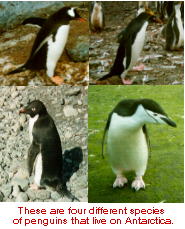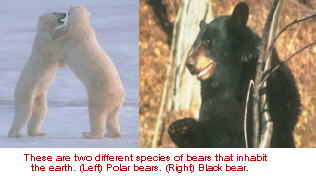
5-1 LIFE AND EARTH'S LIFE-SUPPORT SYSTEMS

What is Life?
The cell is the basic unit of life. All forms of life:


Beneficial mutations give: rise to new genetic traits (adaptive traits) that give an organism an advantage in a changing environment and produce more offspring with those traits - natural selection. Through time these adaptive traits become more prevalent in a population. Evolution is the change in genetic makeup of a population through successive generations. New species can be formed, or is life forms cannot adapt they will decline or become extinct. Biodiversity is a result of the ongoing processes of evol ution and extinction. Biodiversity sustains life and provides genetic raw material for adaptation to future changes in environmental conditions.
What Are the Major Parts of Earth's Life-Support Systems?
You can think of Earth as being made up of layers of concentric spheres:
atmosphere - think envelope of air around the planet
tropospbere - inner layer of atmosphere to 17km above sea level (most of the planet's air, 78% nitrogen and 21% oxygen).
· stratosphere - next layer, 17-48 km above surface. The lower portion contains ozone that filters ultraviolet radiation (allows life to exist).
· hydrosphere - Earth's liquid water (surface, underground ) ice, and vapor.
· lithosphere - Earth's crust and upper mantle (fossil fuels, minerals, and soil nutrients to support life).
ecosphere, or biosphere - where living (biotic) organisms exist and interact with one another and their nonliving (abiotic) environment (thickness of apple skin to an apple).
The goal of ecology is to understand Ihe interactions in this Ihin global skin of air, water, soil, and organisms. What Sustains Life on Earth?
Life on earth depends on three interconnected factors: The one-way flow of high-quality (Usable) energy from the sun. The cycling of matter, or nutrients, needed for survival. Gravity, which alloWS the planet to hold its atmosphere and causes the downward movement of chemicals in the matter cycles.
How Does the Sun Help Sustain Life on Earth?
The sun warms the earth and Supplies the energy for photosynthesis, the process used by green plants and some bacteria to synthesize compounds that keep them alive and feed other organisms. Solar energy powers the cycling of matter cycles and drives the climate and weather systems that distribute heat and fresh water over the earth's system. The sun is middle-aged, wifh 6.5 billion years left.
The sun is 72% hydrogen and 28% helium gases. Due to high temperatures and pressures, hydrogen nuclei fuse to form helium nuclei (nuclear fusion reactor), and emit electromagnetic radiation, Which reaches earth in slightly more than eight minutes. (speed oflight, distance of 150-million km).
Earth receives about one-billionth of this energy, and much ofthis is reflected or absorbed by chemicals in the atmosphere. Most harmful cosmic rays, gamma rays, X-rays, and ultraviolet radiation never reach the surface of Earth. What reaches the troposphere is visible light, infirared radiation (heat) and some UV radiation that is not absorbed by the ozone layer in the stratosphere. About 34% of solar energy reaching the troposphere is reflected back to space (clouds, dust, chemicals, land).
The remaining 66% of solar energy warms the troposphere and land, evaporates water and cycles it, and generates winds. A fraction (0.023%) is captured by green plants and some bacteria and fuels photosynthesis.
The speed with which heat (infrared radiation) flows through the atmosphere and back to space is affected by tropospheric heat-trapping (greenhouse) gases, such as water vapor, carbon dioxide, methane, nitrous oxide, and ozone. Without this atmospheric thermal "blanket" known as the natural greenhouse effect, Earth would be nearly as cold as Mars, and our life could not exist.
Connections: How Do Nutrient Cycles Sustain Life?
A nutrient is any chemical element or compound needed to live, grow or reproduce. Someare needed in large amounts (C, O, H, N, P, S), and others are needed in small or even trace amounts (Na, Fe, Mg, Cy C1, I) (micronutrients).
Nutrient cycles, or biogeochemicai cycles (life-earth-chemical) move nutrients from the nonliving environment (air, water, soil), to living organisms and then back to nonliving environments. These cycles, driven by incoming solar energy and gravity, are carbon, oxygen, nitrogen phosphorus and hydrologic (water) cycles.
Oxygen and carbon cycle quickly (readily available), while phosphorus cycles
slowly (often limits plant growth).

Earth is essentially a closed system in terms of matter, so the chemical cycles are vital. Without death there could be no life. The chemical cycles also connect past, present, and future forms of life.